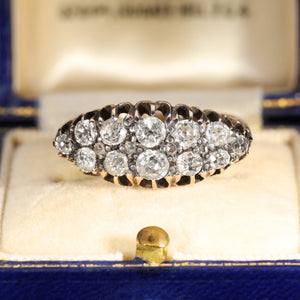How Are Gemstones Made: The Geology Behind the Jewellery
Gemstones captivate us with their vibrant colours and enduring appeal, especially when set in antique or vintage rings where each stone has a story spanning centuries. But how exactly do these precious materials form beneath the Earth’s surface? From mineral crystallisation to the extraordinary pressures and temperatures involved, the geological processes behind gemstone creation are every bit as fascinating as the jewellery they eventually grace. In this post, we’ll explore how gemstones come into being, discuss the forces that shape them, and explain why this geological journey is particularly intriguing for collectors of older, historically significant pieces.
1. The Geological Foundations of Gemstones
Gemstones typically form deep within the Earth, subjected to immense pressure and intense heat. Over time, these conditions allow specific combinations of minerals to crystallise in ways that produce durable, lustrous gems (Read more about lustre here). Key factors include:
- Mineral Composition: Elements such as carbon (in diamonds) or aluminium and oxygen (in corundum) serve as the chemical “building blocks.”
- Crystallisation Environment: Temperature, pressure, and fluid presence influence whether minerals develop clear, gem-quality forms.
- Geological Processes: Activities like volcanic eruptions, hydrothermal vents, and metamorphic rock transformations create the varying conditions that yield diverse gemstones.
1.1 Metamorphic vs. Igneous Origins
While some gemstones, like diamonds, emerge from igneous rocks (often in volcanic “pipes”), others—like emeralds—may result from metamorphic processes where existing rocks are changed by heat or pressure. This distinction affects the availability, location, and ultimate look of each gem, including those often found in antique rings.
2. Common Formation Processes
Different gems have distinct pathways to creation. Here are some notable ones:
- Magmatic Crystallisation: Minerals crystallise from molten rock (magma) beneath the Earth’s surface, producing stones like peridot or certain types of garnet.
- Hydrothermal Formation: Hot, mineral-rich fluids fill cracks in surrounding rocks, crystallising over time. Emeralds and some quartz varieties arise from such hydrothermal veins.
- Pegmatites: These coarse-grained igneous rocks can yield large, high-quality crystals (e.g., tourmaline, aquamarine) prized in fine jewellery—often showcased in vintage rings from certain regions.
- Alluvial Deposits: Erosion can release gems from their original host rock, carrying them into riverbeds or sedimentary layers, where they may be found as water-worn pebbles.
3. Trace Elements and Colour
Many gemstones are inherently colourless in their purest form. Trace elements, however, can lead to the vibrant hues we associate with stones like rubies (chromium) or sapphires (iron and titanium). In older jewellery, these specific trace elements may produce unusual or rarer colour variations, adding to the ring’s collectability and historical intrigue.
3.1 Colour Zoning and Intensity
During crystallisation, temperature and chemistry fluctuate, creating “colour zones” within a single stone. When such gems are cut for antique jewellery, expert lapidaries historically had to decide which zones to emphasise, thus influencing a ring’s final appearance.
4. Why Gemstone Origins Matter for Antique Rings
Beyond aesthetics, understanding a gem’s geological origins can reveal:
- Historic Mines: Some famous mines active hundreds of years ago are now depleted, making gems sourced from these locations exceptionally desirable in vintage rings.
- Rarity and Value: Gemstones formed under rare or highly specific conditions—like Colombian emeralds or Kashmir sapphires—carry premium prices and storied reputations.
- Authenticity Checks: Knowledge of gem formation can help gemmologists identify synthetic or heavily treated stones passed off as antique originals.
5. Tips for Collectors and Enthusiasts
- Look for Provenance: Jewellery with documented origins of its gemstones can boost confidence in the piece’s authenticity and may enhance its value.
- Seek Expert Advice: A trusted gemmologist or reputable antique dealer can validate whether a stone aligns with the historical mining periods or techniques associated with particular eras.
- Appreciate Natural Variations: Imperfections or slight colour variations can be part of an older gem’s charm, reflecting the environment in which it formed.
Conclusion
From molten rock and hydrothermal veins to metamorphic processes deep within the Earth, gemstones undergo astonishing journeys before gracing an antique ring. These geological stories add a rich layer of intrigue to every piece of vintage jewellery, connecting the wearer not just to a period in history, but also to the Earth’s ancient natural processes. By appreciating the geology behind gemstone formation, collectors and enthusiasts can more deeply savour the rare beauties found in historic rings—and truly grasp why each stone is a one-of-a-kind gift from our planet.


